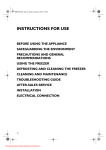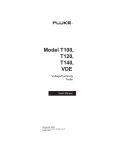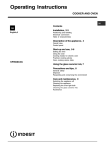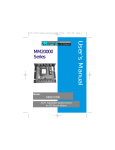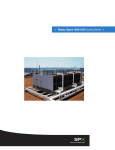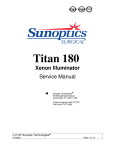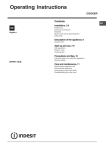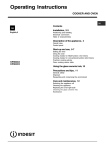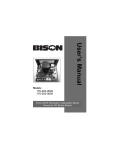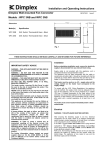Download Whirlpool AFB 910/IS Troubleshooting guide
Transcript
60202011GB.fm Page 14 Thursday, July 12, 2007 5:31 PM INSTRUCTIONS FOR USE BEFORE USING THE APPLIANCE SAFEGUARDING THE ENVIRONMENT PRECAUTIONS AND GENERAL RECOMMENDATIONS USING THE FREEZER DEFROSTING AND CLEANING THE FREEZER CLEANING AND MAINTENANCE TROUBLESHOOTING GUIDE AFTER-SALES SERVICE INSTALLATION ELECTRICAL CONNECTION 14 Downloaded from Fridge-Manual.com Manuals 60202011GB.fm Page 15 Thursday, July 12, 2007 5:31 PM BEFORE USING THE APPLIANCE • Your new appliance is designed exclusively for domestic use. To ensure best use of your appliance, carefully read the instructions which contain a description of the appliance and advice on storing and preserving food. Keep this handbook for future reference. 1. After unpacking the appliance, make sure it is not damaged and that the door closes properly. Any damage must be reported to the dealer within 24 hours of delivery of the appliance. 2. Wait at least two hours before switching the appliance on, in order to ensure that the refrigerant circuit is fully efficient. 3. Make sure installation and the electrical connection are carried out by a qualified technician according to the manufacturer's instructions and in compliance with the local safety regulations 4. Clean the inside of the appliance before using it. SAFEGUARDING THE ENVIRONMENT 1. Packing The packing material is 100% recyclable and bears the recycling symbol. Comply with the local regulations for disposal. Keep the packing materials (plastic bags, polystyrene parts, etc.) out of the reach of children, as they are a potential source of danger. 2. Scrapping/Disposal The appliance is manufactured using recyclable material. This appliance is marked in compliance with European Directive 2002/96/EC on Waste Electrical and Electronic Equipment (WEEE). By ensuring the correct scrapping of this appliance, you can help prevent potentially negative consequences for the environment and the health of persons. The symbol on the appliance, or on the accompanying documents, indicates that this appliance should not be treated as domestic waste but must be taken to a suitable collection centre for the recycling of electrical and electronic equipment. When scrapping the appliance, make it unusable by cutting off the power cable and removing the doors and shelves so that children cannot easily climb inside. Scrap the appliance in compliance with local regulations on waste disposal, taking it to a special collection centre; do not leave the appliance unattended even for a few days, since it is a potential source of danger for children. For further information on the treatment, recovery and recycling of this product, contact your competent local office, the household waste collection service or the shop where you purchased the appliance. Information: This appliance does not contain CFCs. The refrigerant circuit contains R134a (HFCs) or R600a (HCs), see the rating plate inside the appliance. Appliances with isobutane (R600a): Isobutane is a natural gas without environmental impact but is flammable. Therefore, make sure the refrigerant circuit pipes are not damaged. This product contains Fluorinated Greenhouse Gases covered by the Kyoto Protocol, the refrigerant gas being in a hermetically sealed system. Refrigerant gas: R134a has a Global Warming Potential (GWP) 1300. Declaration of conformity • This appliance is intended for storing food and is manufactured in conformity with European regulation (EC) No. 1935/2004. • This product has been designed, manufactured and marketed in compliance with: - the safety objectives prescribed in the Low Voltage Directive 2006/95/CE (which replaced Directive 73/23/CEE as amended); - the protection requirements of the “EMC” 89/336/CEE directive, amended by Directive 93/68/CEE. • Electrical safety of the appliance is guaranteed only if it is connected to an efficient and approved earthing system. 15 Downloaded from Fridge-Manual.com Manuals 60202011GB.fm Page 16 Thursday, July 12, 2007 5:31 PM PRECAUTIONS AND GENERAL RECOMMENDATIONS • During installation, make sure the appliance does not damage the power cable. • Make sure the appliance is not near a heat source. • To guarantee adequate ventilation, leave a space on both sides and above the appliance and follow the installation instructions. • Keep the appliance ventilation openings free. • Power cable modification or replacement must only be carried out by qualified personnel. • It must be possible to disconnect the appliance from the power supply by unplugging it or by means of a mains doublepole switch installed upstream of the socket. • Make sure the voltage specified on the rating plate corresponds to that of your home • Install and level the appliance on a floor strong enough to take its weight and in a place suitable for its size and use. • The appliance must be handled and installed by two or more persons. • Be careful not to damage the floors (e.g. parquet) when moving the appliance. • Do not use single/multi-adapters or extension cords. • Install the appliance in a dry and wellventilated place. The appliance is arranged for operation in places where the temperature comes within the following ranges, according to the climatic class given on the rating plate. The appliance may not work properly if it is left for a long period at a temperature outside the specified range. Climatic Class SN N ST T Amb. T. (°C) From 10 to 32 From 16 to 32 From 16 to 38 From 16 to 43 16 Downloaded from Fridge-Manual.com Manuals Amb. T. (°F) From 50 to 90 From 61 to 90 From 61 to 100 From 61 to 110 • Do not store or use petrol, gas or flammable liquids in the vicinity of this or other electrical appliances. The fumes can cause fires or explosions. • Do not use mechanical, electric or chemical means other than those recommended by the Manufacturer to speed up the defrost process. • Do not damage the appliance refrigerant circuit pipes. • Do not use or place electrical devices inside the appliance compartments, if they are not of the type expressly authorised by the Manufacturer. • This appliance is not intended for use by persons (including children) with reduced physical, sensory or mental capabilities, or lack of experience and knowledge, unless they have been given supervision or instruction concerning use of the appliance by a person responsible for their safety. Children should be supervised to ensure that they don't play with the appliance. • Do not swallow the contents (non-toxic) of the ice packs (if provided). • Use the refrigerator compartment only for storing fresh food and the freezer compartment only for storing frozen food, freezing fresh food and making ice cubes. • Do not store glass containers with liquids in the freezer since they may burst. • Do not eat ice cubes or ice lollies immediately after taking them out of the freezer since they may cause cold burns. • Before carrying out any maintenance or cleaning operation, unplug the appliance or disconnect it from the power supply. • The Manufacturer declines any liability if the above advice and precautions are not respected. 60202011GB.fm Page 17 Thursday, July 12, 2007 5:31 PM USING THE FREEZER The freezer can be used for storing already frozen food and for freezing fresh food. Control unit Switching on the freezer for the first time • The freezer temperature does not have to set with the thermostat because the appliance is already factory-set. • Plug in the appliance. • Only place food in the freezer 2 hours after switching on. Storage baskets Temperature adjustment Settings from MIN to MAX: increase the cooling temperature. • Thermostat setting: MIN - storing food for short periods; NORMAL - storing food for longer periods; MAX + SUPER - storing food for long periods and freezing food. Note: The room temperature, how often the door is opened and the position of the appliance can affect the temperature inside the freezer. Take these factors into account when setting the thermostat. Adjustment devices Freezing Place the maximum amount indicated on the rating plate, in the middle compartment, taking care not to place it in contact with already frozen food. For optimum appliance performance, turn the thermostat knob to Super, introduce the food to be frozen, and after 24 hours turn the knob back to Normal. About 24 hours' on “SUPER” after introducing the food is generally sufficient; after this period, deactivate the “SUPER” function (if present). Control unit NORMAL MIN MAX SUPER Important: When freezing small amounts of food, the food can be placed in any compartment except the bottom drawer. Also, in order to save energy, the fast freeze function (if present) does not have to be activated. 17 Downloaded from Fridge-Manual.com Manuals 60202011GB.fm Page 18 Thursday, July 12, 2007 5:31 PM Advice for freezing and storing fresh food. • Before freezing, wrap and seal fresh food in: aluminium foil, transparent film, waterproof plastic bags, polyethylene containers with lids or freezer containers suitable for the food being frozen. • Food must be fresh and of prime quality. • If possible, fresh vegetables and fruit should be frozen immediately after being picked, to preserve the nutritional substances, structure, consistency, colour and flavour. Note: • Always leave hot food to cool before placing in the freezer. • Consume fully or partially thawed foods immediately. Do not refreeze unless the thawed food is used to prepare a ready meal. Once cooked, the thawed food can be refrozen. Important: The table opposite gives the recommended storage times for frozen fresh foods. Classification of frozen foods Put the frozen products in the freezer and classify them. It is advisable to indicate the storage date on the packs, to ensure their use before the expiry dates. MONTHS Advice for storing deep-frozen food When purchasing deep-frozen food products: • Make sure the packaging is not damaged, otherwise the food can deteriorate. If the package is swollen or has damp patches, it has not been stored in optimum conditions and may have started to thaw. • Purchase frozen food last and use thermal bags to carry it. • Place frozen foods in the freezer as soon as you get home. • Do not refreeze partially thawed food products; consume them within 24 hours. • Avoid or reduce temperature variations to a minimum. Respect the expiry date on the pack. • Always follow the instructions given on the pack for storing frozen foods. 18 Downloaded from Fridge-Manual.com Manuals FOOD 60202011GB.fm Page 19 Thursday, July 12, 2007 5:31 PM Removing the drawers • Pull out the drawers as far as they go, then lift slightly and remove. Note: The drawers can be removed in order to obtain more space. Make sure that the load does not exceed the limit (if present) indicated on the side walls of the appliance. Making ice cubes • Fill the ice cube tray 2/3 full and place it in the special freezer compartment. • Do not use sharp or pointed instruments to detach the tray if it is stuck to the bottom of the freezer. • Bend the ice tray slightly to remove the cubes. Fig. 1 Note: The freezer door will not re-open easily immediately after closing. Wait a few minutes before opening again in order to allow for compensation of the vacuum created. 19 Downloaded from Fridge-Manual.com Manuals 60202011GB.fm Page 20 Thursday, July 12, 2007 5:31 PM DEFROSTING AND CLEANING THE FREEZER Before any cleaning or maintenance operation, always unplug the appliance or disconnect it from the power supply. Defrost the freezer once or twice a year, or when the frost on the refrigeration grills is excessive. It is perfectly normal for frost to form on the grills. The amount of frost and the speed at which it accumulates depend on room conditions how often the door is opened, and tends to accumulate more on the upper grills. It is advisable to defrost the freezer when it is nearly empty. • Open the door and remove all food products, wrapping them close together in newspaper and place in a very cool place or in a portable cooler. • Leave the freezer door open to allow the frost to melt. • Clean the inside of the freezer with a sponge soaked in lukewarm water and/or neutral detergent. Do not use abrasive substances. • Rinse and dry thoroughly. • Put the food back into the freezer. • Close the freezer door. • Plug in the appliance. • Switch the freezer on. CLEANING AND MAINTENANCE Periodically clean the condenser at the back of the appliance with a vacuum cleaner or brush. For long vacations • • • • Empty the freezer. Disconnect the freezer from the power supply. Defrost and clean the inside. Leave the door open to prevent the formation of unpleasant odours and to eliminate the moisture inside. 20 Downloaded from Fridge-Manual.com Manuals 60202011GB.fm Page 21 Thursday, July 12, 2007 5:31 PM TROUBLESHOOTING GUIDE 1. The appliance does not work. •Is there a power failure? •Is the main switch turned on? •Are the household electrical system protection devices efficient? •Is the thermostat correctly set? •Was the appliance switched on correctly? Notes: • If the front edge of the appliance is hot, this is not a defect but prevents the formation of condensate. • Gurgling and hissing noises due to expansion in the refrigerant circuit are normal. 2. Excessive frost build-up. •Is the defrost water drain correctly positioned? •Was the door properly shut? AFTER-SALES SERVICE Before contacting the After-Sales Service: 1. See if you can solve the problems on your own (see “Troubleshooting guide”). 2. Switch the appliance on again to see if the problem has been eliminated. If it has not, disconnect the appliance again and repeat the operation after one hour. 3. If the problem persists, contact the After-Sales Service. Specify: •the type of fault, •the model, •the Service number (the number after the word SERVICE on the rating plate inside the appliance), •your full address, •your telephone number and area code. 21 Downloaded from Fridge-Manual.com Manuals 60202011GB.fm Page 22 Thursday, July 12, 2007 5:31 PM INSTALLATION • Install the freezer away from heat sources. Installation in a hot place, direct exposure to sunlight or placing it near a heat source (radiators, cookers) will increase energy consumption and should therefore be avoided. • If this is not possible, the following minimum distances must be respected: • 30 cm from coal or oil stoves; • 3 cm from electric and/or gas cookers. • Install in a dry and well-ventilated place. • Clean the inside (see “Defrosting and cleaning the freezer”). • Fit the accessories supplied. • Fit the spacers (Fig. 1, 2, or 3, depending on the model) Electrical connection • Electrical connections must be made in compliance with local regulations. • Data regarding voltage and electrical absorption are specified on the rating plate inside the appliance. • Earthing of the appliance is compulsory by law. The Manufacturer declines any liability for injury to persons and animals or damage due to noncompliance with the above regulations. • If the plug and socket are not of the same type, have the socket replaced by a qualified technician. • Do not use extension leads or multi-adapters. Electrical disconnection It must be possible to electrically disconnect the appliance by unplugging it or by means of a double-pole switch installed upstream of the socket. Door reversibility If required, door opening can be reversed from right to left (depending on how it is supplied). Caution! When reversing the door opening, the appliance must not be connected to the power supply. The appliance must be previously unplugged. Tilt the appliance backwards a little and prop it in a secure position. Undo the door hinge screws and remove the hinge pin bracket. Open the door slightly and lower it. Undo the top pin and screw it in place on the opposite side. Insert the door on the top hinge and close it. Tighten the hinge pin bracket in place on the opposite side using the screws. 22 Downloaded from Fridge-Manual.com Manuals 60202011GB.fm Page 23 Thursday, July 12, 2007 5:31 PM Installation requirements To ensure correct appliance operation, it must not be exposed to temperatures below 16 °C or above 32 °C. It is advisable to avoid the following places: kitchens without ventilation, outside rooms, greenhouses, garages. In order to operate correctly, the appliance must be installed: in a dry place. Away from direct sunlight. Away from extreme temperatures (away from cookers or other heat sources). When full, the appliance will be heavy, and therefore it must be placed on a strong and solid floor. Ventilation requirements Carefully push the freezer in place, until reaching the appropriate distance from the wall. When in place, a space of 50 mm above the appliance must be maintained. If the space is not available above the appliance, leave a space of 25mm on both sides. Make sure the appliance does not squash the power cable. The parts that can become hot must not be exposed. When possible, the back part of the appliance must be close to the wall, leaving the required space for ventilation. Levelling The appliance must be level; to eliminate rocking: make sure the appliance is vertical and that both adjustment devices are in close contact with the floor, so that the compartment is level. Adjust the level by unscrewing the appropriate adjustment device, located at the front (use fingers or a screwdriver). The appliance is heavy. Pay attention when moving it. * For specific details please refer to the rating plate located on the back of the freezer. The specifications are subject to change without notice. WALL Note: If reversing of door opening is carried out by the After-sales Service the work is not covered by the warranty. 23 Downloaded from Fridge-Manual.com Manuals 60202011GB.fm Page 24 Thursday, July 12, 2007 5:31 PM ELECTRICAL CONNECTION 1) For Great Britain only Warning - this appliance must be earthed Fuse replacement If the mains lead of this appliance is fitted with a BS 1363A 13amp fused plug, to change a fuse in this type of plug use an A.S.T.A. approved fuse to BS 1362 type and proceed as follows: 1. Remove the fuse cover (A) and fuse (B). 2. Fit replacement 13A fuse into fuse cover. 3. Refit both into plug. Important: The fuse cover must be refitted when changing a fuse and if the fuse cover is lost the plug must not be used until a correct replacement is fitted. Correct replacement are identified by the colour insert or the colour embossed in words on the base of the plug. Replacement fuse covers are available from your local electrical store. 2) For the Republic of Ireland only The information given in respect of Great Britain will frequently apply, but a third type of plug and socket is also used, the 2-pin, side earth type. 3) Socket outlet / plug (valid for both countries) If the fitted plug is not suitable for your socket outlet, please contact Whirlpool Service for further instruction. Please do not attempt to change plug yourself. This procedure needs to be carried out by a qualified Whirlpool technician in compliance with the manufactures instructions and current standard safety regulations. 24 Downloaded from Fridge-Manual.com Manuals











